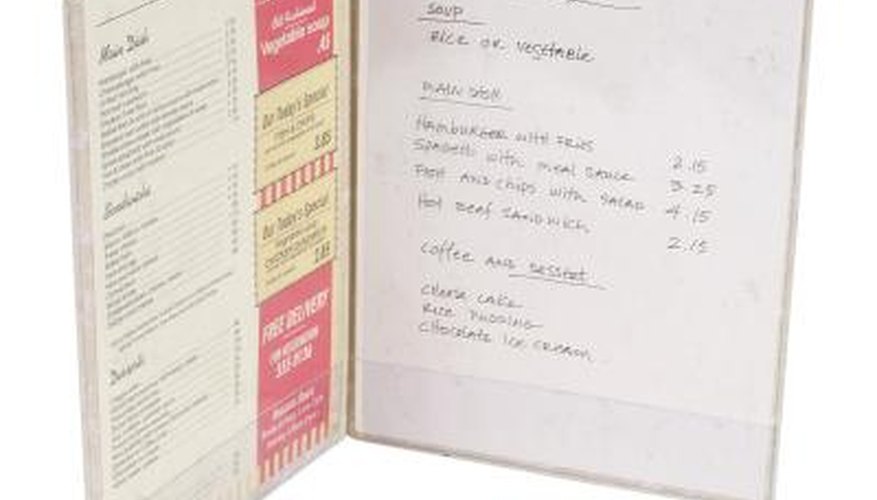The menu of a restaurant is a very personal thing. It not only provides customers with information about the food that is served there, but it also communicates information about the style of the restaurant and sets the mood for the restaurant.
Make a new file in GIMP by clicking on the "File" menu and selecting "New." Enter the width and height of one page of your menu. So if you will print it on a standard sheet of paper or card stock, the width would be 8.5 inches and the height would be 11 inches. You will need to make a separate file in GIMP for each page or each side of the menu.
Click to select the text tool for each block of text and choose a font and size from the text tool options at the bottom of the toolbar. The fonts should be readable but set a mood similar to your restaurant's theme. Script fonts have a romantic look, and sans serif fonts have a modern, everyday feel suitable to a lunch cafe. Click anywhere on your page and type the text. Re-size the boundaries of the text block by dragging the handles on the corners. Change the font, size and other options as desired. You will have to make a separate text block for each bit of text that has a different font or size.
- The menu of a restaurant is a very personal thing.
- Click to select the text tool for each block of text and choose a font and size from the text tool options at the bottom of the toolbar.
Use the rectangular selection tool to draw any frames you want to use to highlight a section of the menu. Then select the pattern fill tool and click anywhere inside the rectangle selection to fill it with the foreground colour. Use this technique again until you have the frames you want. Position them as needed on the page.
Add any photos or logos by copying them from another image file and using "Paste as new layer" from the "Edit" menu. Use the move tool to move them around, and use the "Scale layer" option in the "Layers" menu to change the size of the object, if necessary.
Save each image as an XCF file, the native file format for GIMP. Then save it again as a JPG or PNG so you can give the menu to the printer for printing.
- Use the rectangular selection tool to draw any frames you want to use to highlight a section of the menu.
- Then save it again as a JPG or PNG so you can give the menu to the printer for printing.
TIP
Before creating your menu, decide on a size and format for the menu. The size may be limited by menu sleeves you're using. Your menu can be one page, folded to contain four pages or have even more pages. Your choice is mostly determined by the number of menu items you have for sale and your budget for printing the menu. Determine a colour scheme. It is best to choose two or three main colours. The colour scheme should match your restaurant decor but should allow for contrast so the menu will be readable. Often you can achieve this by using a light colour of paper or card stock and a dark colour for the fonts. Pick an accent colour for headlines and other graphic accents. Write a rough draft of your menu ahead of time. Decide on basic sections for appetizers, entrées, desserts and beverages. If you have a lot of entrées, you might divide them into categories to make the menu easier to read. Also consider what items you want to encourage your customers to purchase. You may want to highlight these items in some way: by placing them at the top of a page, putting a frame around them or using your accent colour for the title of the entrée you are highlighting. If you have the text written in your word processor, you can copy and paste them into the text box as you go, once you start working in GIMP.
